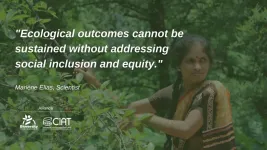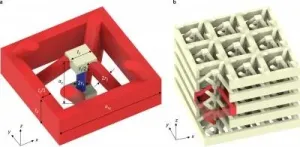The rocky road to accurate sea-level predictions
Dirt and water under Greenland control future sea
2021-06-10
(Press-News.org) The type of material present under glaciers has a big impact on how fast they slide towards the ocean. Scientists face a challenging task to acquire data of this under-ice landscape, let alone how to represent it accurately in models of future sea-level rise.
"Choosing the wrong equations for the under-ice landscape can have the same effect on the predicted contribution to sea-level rise as a warming of several degrees", says Henning Åkesson, who led a new published study on Petermann Glacier in Greenland.
Glaciers and ice sheets around the world currently lose more than 700,000 Olympic swimming pools of water every day. Glaciers form by the transformation of snow into ice, which is later melted by the atmosphere in summer, or slides all the way into the sea. With climate change, glaciers are breaking up and drop icebergs into the ocean at an accelerating pace. Exactly how fast depends to a large extent on the bed below all the ice. Glaciers conceal a landscape under the ice covered by rocks, sediments and water. A new study shows that the way we represent this under-ice landscape in computer models means a great deal for our predictions of future sea-level rise. More specifically, how we incorporate the friction between the ground and the ice sliding over it in glacier models is what affects our predictions. This was found by a team of Swedish and American scientists, when they simulated the future of Petermann Glacier, the largest and fastest glacier in northern Greenland.
Petermann is one of the few glaciers in the northern hemisphere with a remaining ice tongue, a type of floating glacier extension otherwise mainly found in Antarctica, where they are called ice shelves. These floating extensions have been found to be exposed to warm subsurface water flowing from the open ocean towards the glaciers. This happens both in Antarctica and in many fjords around Greenland, including the Petermann Fjord.
"Peterman lost 40% of its floating ice tongue over the last decade. It still has a 45 km tongue, but we found that a slightly warmer ocean than today would lead to its break up, and trigger a retreat of the glacier", says Henning Åkesson, a postdoctoral researcher at Stockholm University who led the study.
Many glaciers in Greenland and Antarctica flow towards the ocean much faster than they did a few decades ago, and therefore contribute more to global sea-level rise. Scientists have therefore mobilized great efforts into learning what is going on in these environments. This has spurred new insights into the landscape under glaciers and the shape of the seafloor where they drain. We now also know much more about what happens to the ice when glaciers meet the sea.
Still, the remote polar regions are notoriously difficult to study because of sea ice, icebergs, and often harsh weather. The under-ice landscape is a particular challenge because, frankly, it is hard to measure something covered by a kilometer of ice on top. Even in areas of known under-ice topography, describing its physical properties using mathematical equations is difficult. Computer models are therefore still somewhat in the dark when it comes to how to represent things like sediments, rocks, ponds and rivers under glaciers in the equations that describe ice flow. These equations are ultimately the foundation of the models used by the IPCC to estimate how fast glaciers flow and how much sea levels will rise under future climate warming.
"As we said, choosing the wrong equations for the under-ice landscape can have the same effect on the contribution to sea-level rise as a warming of several degrees", Åkesson says.
"In fact, predicted sea-level rise for this Greenland glacier can quadruple depending on how we represent friction under the ice. We still don't know which way is the best, but our study illustrates that ice-sheet models still need to progress in this respect, in order to improve our estimates of mass loss from Earth's polar ice sheets."
INFORMATION:
[Attachments] See images for this press release:

ELSE PRESS RELEASES FROM THIS DATE:
2021-06-10
With the start of the United Nations' Decade on Ecosystem Restoration, which runs through 2030, a tremendous amount of money and effort will be put into re-growing forests, making over-exploited farmland productive, and reviving damaged marine environments. This is a good, and vital, initiative. Without quick action to clean up the fallout of humanity's scorched-earth economic systems, goals on hunger, biodiversity and climate will be unattainable.
But in examining restoration projects already underway across the globe, a group of scientists has found that restoration action is at risk of failure if it doesn't make ...
2021-06-10
Palaeoclimatologists study climate of the geological past. Using an innovative technique, new research by an international research team led by Niels de Winter (VUB-AMGC & Utrecht University) shows for the first time that dinosaurs had to deal with greater seasonal differences than previously thought.
De Winter: "We used to think that when the climate warmed like it did in the Cretaceous period, the time of the dinosaurs, the difference between the seasons would decrease, much like the present-day tropics experience less temperature difference between ...
2021-06-10
Inaccessible workplaces, normative departmental cultures and 'ableist' academic systems have all contributed to the continued underrepresentation and exclusion of disabled researchers in the Geosciences, according to an article published today (Thursday 8 June) in Nature Geosciences.
The article argues that changes to both working spaces and attitudes are urgently needed if institutions are to attract, safeguard and retain people with disabilities.
Anya Lawrence, a disabled early career researcher in the University of Birmingham's School of Geography, Earth and Environmental Science and author of the piece says:
"Disabled geoscientists like myself face barrier after barrier on a daily ...
2021-06-10
People who smoke, suffer from high blood pressure, obesity, or diabetes are not only at greater risk of suffering a stroke, heart attack, or dementia. For them, the risk of being affected by depressive mood or depression also increases. The more risk factors a person has, the more likely this is. Until now, however, it was unclear whether this probability also depends on their age. Earlier studies had already shown for other diseases such as dementia or stroke that a combination of several risk factors leads to a more frequent onset of the disease between the ages of 40 and 65 than in old age. Until now, however, it was unclear whether this also applies to depression.
Researchers ...
2021-06-10
MORGANTOWN, W. Va.-- Joining a club that sparks a new interest, playing a new intramural sport or finding a new group of friends may be just as indicative of a college freshman's loss of self-control as drinking or drug use, according to new research at West Virginia University.
Self-control--the ability to exercise personal restraint, inhibit impulsivity and make purposeful decisions--in that first year partly depends on a student's willingness to try new things, including things adults would call "good."
That's a new finding, according to Kristin Moilanen, associate professor of child development and family studies. The study, "Predictors of initial status and change in self-control during the college transition," observed 569 first year ...
2021-06-10
DURHAM, N.C. - Biomedical engineers at Duke University have demonstrated that a class of interwoven composite materials called semi-interpenetrating polymer networks (sIPNs) can be produced by living cells. The approach could make these versatile materials more biologically compatible for biomedical applications such as time-delayed drug delivery systems.
The research appears online on June 8 in the journal Nature Communications.
The concept of sIPNs has been around for more than 100 years and has been used in automotive parts, medical devices, molding compounds and engineering plastics. The general idea is for one or more polymers to assemble around another polymer scaffold in such a way that they become interlocked. Even though ...
2021-06-10
Humans expect that AI is Benevolent and trustworthy. A new study reveals that at the same time humans are unwilling to cooperate and compromise with machines. They even exploit them.
Picture yourself driving on a narrow road in the near future when suddenly another car emerges from a bend ahead. It is a self-driving car with no passengers inside. Will you push forth and assert your right of way, or give way to let it pass? At present, most of us behave kindly in such situations involving oth-er humans. Will we show that same kindness towards autonomous vehicles?
Using methods ...
2021-06-10
As COVID-19 restrictions ease nationwide and more people host indoor gatherings, investing in a high efficiency particulate air (HEPA) purifier might not be a bad idea, says a University of Cincinnati College of Medicine researcher.
Several published studies evaluating aerosols and submicron particles similar in size to the SARS-CoV-2 virion have shown that portable HEPA purifiers are able to significantly reduce airborne COVID-19 particles, says Ahmad Sedaghat, MD, PhD, director of the UC Division of Rhinology, Allergy and Anterior Skull Base Surgery.
Sedaghat identified the medical literature showing published studies on the effectiveness ...
2021-06-10
Acoustic waves in gases, liquids, and solids usually travel at an almost constant speed of sound. So-called rotons are an exception: their speed of sound changes significantly with the wavelength, and it is also possible that the waves travel backwards. Researchers at Karlsruhe Institute of Technology (KIT) are studying the possibilities of using rotons in artificial materials. These computer-designed metamaterials, produced by ultra-precise 3D laser printing, might be used in the future to manipulate or direct sound in ways that have never been possible before. A report on the researchers' work has been published in Nature Communications. (DOI: 10.1038/s41467-021-23574-2)
Rotons are quasiparticles, which means that they behave ...
2021-06-10
New Orleans, LA - Research conducted at LSU Health New Orleans Neuroscience Center of Excellence reports that Elovanoids, bioactive chemical messengers made from omega-3 very-long-chain polyunsaturated fatty acids discovered by the Bazan lab in 2017, may block the virus that causes COVID-19 from entering cells and protect the air cells (alveoli) of the lung. Their findings are published online in Scientific Reports, available here.
"Because the compounds are protective against damage in the brain and retina of the eye and the COVID-19 virus clearly damages the lung, ...
LAST 30 PRESS RELEASES:
[Press-News.org] The rocky road to accurate sea-level predictions
Dirt and water under Greenland control future sea






